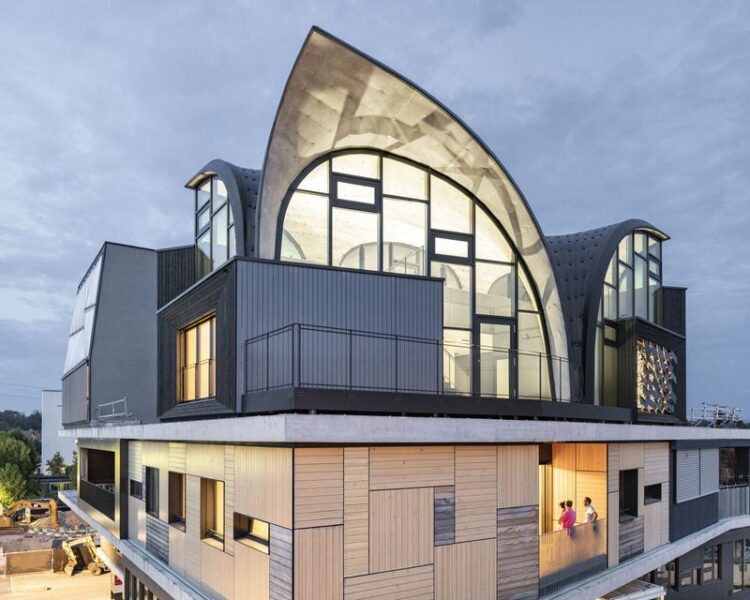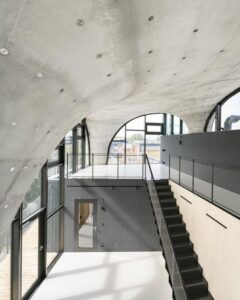Light construction, efficient operation

The HiLo unit sits on the top platform of the NEST research and innovation building on the Empa campus in Dubendorf, Switzerland.
(c) Roman Keller / Empa
Boasting an intricate, doubly curved concrete roof, lightweight funicular floors, and self-learning building technology, the latest addition to Empa and Eawag’s NEST research building in Duebendorf, Switzerland officially opened today. The innovative unit illustrates nearly a decade of formative ETH Zurich research in architecture and sustainable technologies.

(c) Roman Keller / Empa
HiLo, the latest NEST unit, combines medieval building principles with futuristic construction methods: the two-storey building module with its striking, doubly curved concrete roof and novel, lightweight funicular floor system was inspired by construction methods of the past, and planned and built using state-of-the-art computational design and fabrication techniques. In the new unit, a team of scientists led by Philippe Block, Professor of Architecture and Structures, and Arno Schlueter, Professor of Architecture and Building Systems together with industrial partners explored how lightweight structures and efficient construction methods can be combined with intelligent and adaptive building systems to reduce both embodied and operational emissions in the construction and building industry.
Resource-efficient concrete structures
The unit’s striking roof derives its load-bearing capacity from its highly curved geometry combined with a concrete sandwich structure, made of two thin layers of reinforced concrete connected by a grid of concrete ribs and steel anchors. To save large amounts of formwork material, the roof was built using a flexible formwork consisting of a tensioned cablenet covered with a thin membrane onto which the concrete was sprayed.
For the mezzanine floors of the two-storey unit, the researchers primarily aimed to use as little material as possible in the structure itself. By using a rib-stiffened funicular shell instead of a flat plate, HiLo’s lightweight funicular system uses over 70 percent less material than conventional floor slabs in reinforced concrete. Furthermore, digital production methods allowed the integration of ventilation, cooling, and low temperature heating systems into the floor structure for an even greater reduction in materials and volume.
Learning building technology
The HiLo unit is also equipped with an adaptive solar façade developed by Schlueter’s group. It consists of 30 photovoltaic modules that can be aligned with the sun. The flexible modules can also be used to control how sunlight enters the room in order to passively heat it or reduce cooling requirements.
The adaptive solar façade is one of a series of innovative building technology components designed for efficient indoor climate regulation. During operation, the researchers consistently optimised the interplay of the individual technologies using machine learning and considering the users, in order to investigate how comfortable indoor conditions can be achieved with as little energy and emissions as possible.
Research and industry learn from each other
HiLo stands for “high performance – low emissions”. The unit allows researchers to test how the construction and operation of buildings can be designed to be as energy- and resource-efficient as possible, while at the same time ensuring an attractive architectural space and a high level of comfort.
HiLo is the eighth module in the experimental NEST building on the campus of the two research institutions Empa and Eawag in Duebendorf, Switzerland (just outside of Zurich). In the modular research and innovation building, scientists and industry partners can test and advance new building and energy technologies in temporary building modules or units and under “real-life” conditions.
Wissenschaftliche Ansprechpartner:
Peter Richner
Empa, Deputy CEO / Head of the Department of Engineering Sciences
peter.richner@empa.ch
Philippe Block
ETH Zurich, Block Research Group
block@arch.ethz.ch
Architecture and Building Systems A/S
Alessandra Gabaglio, Communications
gabaglio@arch.ethz.ch
Press contacts
Stephan Kaelin
Empa, Communications
Tel. +41 58 765 49 93
stephan.kaelin@empa.ch
Vanessa Bleich
ETH Zurich, Corporate Communications
Tel. +41 44 632 41 41
vanessa.bleich@hk.ethz.ch
Weitere Informationen:
https://www.empa.ch/web/s604/hilo-opening Empa media release
https://www.empa-virtual.ch/nest/de/hilo-opening/ Virtual tour
Media Contact
All latest news from the category: Architecture and Construction
Newest articles

Properties of new materials for microchips
… can now be measured well. Reseachers of Delft University of Technology demonstrated measuring performance properties of ultrathin silicon membranes. Making ever smaller and more powerful chips requires new ultrathin…

Floating solar’s potential
… to support sustainable development by addressing climate, water, and energy goals holistically. A new study published this week in Nature Energy raises the potential for floating solar photovoltaics (FPV)…

Skyrmions move at record speeds
… a step towards the computing of the future. An international research team led by scientists from the CNRS1 has discovered that the magnetic nanobubbles2 known as skyrmions can be…





















